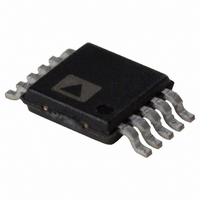AD9833BRMZ-REEL7 Analog Devices Inc, AD9833BRMZ-REEL7 Datasheet - Page 14

AD9833BRMZ-REEL7
Manufacturer Part Number
AD9833BRMZ-REEL7
Description
10 Bit, 10 Pin DDS I.C.
Manufacturer
Analog Devices Inc
Specifications of AD9833BRMZ-REEL7
Resolution (bits)
10 b
Master Fclk
25MHz
Tuning Word Width (bits)
28 b
Voltage - Supply
2.3 V ~ 5.5 V
Operating Temperature
-40°C ~ 105°C
Mounting Type
Surface Mount
Package / Case
10-MSOP, Micro10™, 10-uMAX, 10-uSOP
Lead Free Status / RoHS Status
Lead free / RoHS Compliant
For Use With
EVAL-AD9833EBZ - BOARD EVAL FOR AD9833
Lead Free Status / Rohs Status
Compliant
Available stocks
Company
Part Number
Manufacturer
Quantity
Price
Company:
Part Number:
AD9833BRMZ-REEL7
Manufacturer:
AD
Quantity:
14 592
Part Number:
AD9833BRMZ-REEL7
Manufacturer:
ADI/亚德诺
Quantity:
20 000
AD9833
Table 6. Description of Bits in the Control Register
Bit
D13
D12
D11
D10
D9
D8
D7
D6
D5
D4
D3
D2
D1
D0
Name
B28
HLB
FSELECT
PSELECT
Reserved
Reset
SLEEP1
SLEEP12
OPBITEN
Reserved
DIV2
Reserved
Mode
Reserved
The FSELECT bit defines whether the FREQ0 register or the FREQ1 register is used in the phase accumulator.
SLEEP12 = 1 powers down the on-chip DAC. This is useful when the AD9833 is used to output the MSB of the DAC data.
Function
Two write operations are required to load a complete word into either of the frequency registers. B28 = 1 allows a
complete word to be loaded into a frequency register in two consecutive writes. The first write contains the 14 LSBs of
the frequency word, and the next write contains the 14 MSBs. The first two bits of each 16-bit word define the
frequency register to which the word is loaded and should, therefore, be the same for both of the consecutive writes.
See Table 8 for the appropriate addresses. The write to the frequency register occurs after both words have been
loaded; therefore, the register never holds an intermediate value. An example of a complete 28-bit write is shown in
Table 9. When B28 = 0, the 28-bit frequency register operates as two 14-bit registers, one containing the 14 MSBs and
the other containing the 14 LSBs. This means that the 14 MSBs of the frequency word can be altered independent of
the 14 LSBs, and vice versa. To alter the 14 MSBs or the 14 LSBs, a single write is made to the appropriate frequency
address. The control bit D12 (HLB) informs the AD9833 whether the bits to be altered are the 14 MSBs or 14 LSBs.
This control bit allows the user to continuously load the MSBs or LSBs of a frequency register while ignoring the
remaining 14 bits. This is useful if the complete 28-bit resolution is not required. HLB is used in conjunction with D13
(B28). This control bit indicates whether the 14 bits being loaded are being transferred to the 14 MSBs or 14 LSBs of the
addressed frequency register. D13 (B28) must be set to 0 to be able to change the MSBs and LSBs of a frequency word
separately. When D13 (B28) = 1, this control bit is ignored. HLB = 1 allows a write to the 14 MSBs of the addressed
frequency register. HLB = 0 allows a write to the 14 LSBs of the addressed frequency register.
The PSELECT bit defines whether the PHASE0 register or the PHASE1 register data is added to the output of the phase
accumulator.
This bit should be set to 0.
Reset = 1 resets internal registers to 0, which corresponds to an analog output of midscale. Reset = 0 disables reset.
This function is explained further in Table 13.
When SLEEP1 = 1, the internal MCLK clock is disabled, and the DAC output remains at its present value because the
NCO is no longer accumulating. When SLEEP1 = 0, MCLK is enabled. This function is explained further in Table 14.
SLEEP12 = 0 implies that the DAC is active. This function is explained further in Table 14.
The function of this bit, in association with D1 (mode), is to control what is output at the VOUT pin. This is explained
further in Table 15. When OPBITEN = 1, the output of the DAC is no longer available at the VOUT pin. Instead, the MSB
(or MSB/2) of the DAC data is connected to the VOUT pin. This is useful as a coarse clock source. The DIV2 bit controls
whether it is the MSB or MSB/2 that is output. When OPBITEN = 0, the DAC is connected to VOUT. The mode bit
determines whether it is a sinusoidal or a ramp output that is available.
This bit must be set to 0.
DIV2 is used in association with D5 (OPBITEN). This is explained further in Table 15. When DIV2 = 1, the MSB of the DAC
data is passed directly to the VOUT pin. When DIV2 = 0, the MSB/2 of the DAC data is output at the VOUT pin.
This bit must be set to 0.
This bit is used in association with OPBITEN (D5). The function of this bit is to control what is output at the VOUT pin
when the on-chip DAC is connected to VOUT. This bit should be set to 0 if the control bit OPBITEN = 1. This is explained
further in Table 15. When mode = 1, the SIN ROM is bypassed, resulting in a triangle output from the DAC. When mode = 0,
the SIN ROM is used to convert the phase information into amplitude information, which results in a sinusoidal signal
at the output.
This bit must be set to 0.
Rev. C | Page 14 of 24














